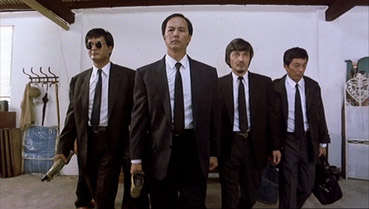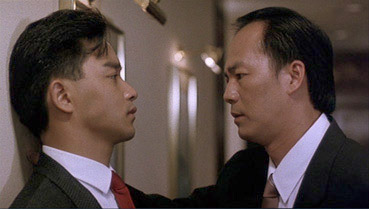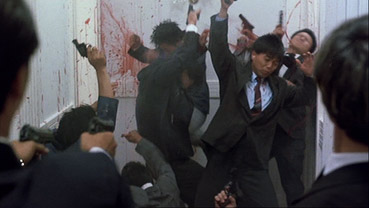This
review assumes you have seen A Better Tomorrow
and briefly discusses plot points that will act as spoilers
if you haven't.
If
you're a fan of action cinema you should already have seen
John Woo's 1986 A Better Tomorrow. If not,
do so right now. This is the film that effectively gave
birth to the 'Heroic Bloodshed' genre and set the style
for pretty much all of Woo's subsequent Hong Kong work,
in its spectacular action choreography, in its themes of
brothers (in blood or spirit) on opposing sides who are
united in a final showdown against a common enemy, in the
director's relationship with lead actor Chow Yun-fat, and
in its love affair with guns, guns, guns.
A
Better Tomorrow II picks up where the first film
left off. Sung Ji Hou is serving time for his past misdemeanours,
while his young brother Jiht is doing fine as a detective
in the Hong Kong police. His latest case has him attempting
to infiltrate an international counterfeiting ring by getting
friendly with Peggy, the daughter of one-time Triad Lung
Sei and the man the outgoing police chief suspects is the gang leader. Deciding on a two-pronged attack, the cops
also lean on Hou to use his past friendship with Sei to
chummy his way into the gang, something he resists until
he realises that Jiht is also on the case. As you might
expect, things don't go exactly to plan. The pair discover
that Sei really has put his past life firmly behind him,
but that his shipyard business is under threat from Triad
gang leader Wong, whose attempts to intimidate Sei backfire
on just about everyone – Wong ends up dead and Sei
is in the frame for his murder. While Hou works on getting
Sei into hiding, Jiht looks out for Peggy, which leaves him with some explaining to do to his pregnant wife. Both men
are effectively back to square one, but out of loyalty to
his friend, Hou becomes determined to find a way to infiltrate
and expose those responsible for Sei's predicament.

Fans
of the original will come to this film with certain expectations
that you can't help but suspect Woo is deliberately playing
games with. For much of the film's length action takes something of a
back seat to drama, with the inevitable shoot-outs for the
most part in the shadow of those in the original.
Emotionally playing to the gallery at times (the sentimental
song that wafts over the soundtrack when one character is
killed is a painfully familiar element of Hong Kong action
cinema), the film sketches its characters in unsurprisingly
broad strokes, graduating to a king-sized wallpaper brush when the
language switches from Chinese to English, which Woo clearly
had no ear for at this stage in his career. The story unfolds a little
unevenly, and Jiht continues to make a target of himself
by wearing white at night and always going in alone, but
the locations have been expanded from Part 1 to include
New York, where Lung Sei is shipped off to and where Mark's
twin brother Ken runs a Chinese restaurant.
Oh
yes, Ken. Nowadays just about every action film you'll stumble
into is planned with a possible sequel in mind, which is
why it's prudent to keep all of the key characters alive, but in the
days of planned one-offs you were free to kill just about
any character you pleased. This only presented a problem
if the film was a hit and one of the dead characters had proved to be a key
reason for its popularity. Come time for a sequel the studio wants him back in the story,
but you've killed him off. So what do you do? Any solution you come
up with is lumbered with an "Oh come on!" factor,
whether it be that he didn't die after all, despite what
you think you saw or heard (Whistler in Blade II),
or that he had a twin brother that he never thought to mention
while he was still on planet Earth. A twin brother like
our Ken in New York. Mark, as you will remember, was the
first film's killer-fallen-from-grace, enigmatically played
by the always impressive Chow Yun-fat. Shot to shit in the
final battle, he died attempting to reunite the estranged
Sung brothers. Clearly, if you're putting together a sequel
you just HAVE to have Chow Yun-fat on board. So Mark had
a twin brother, a twin brother who proves just reckless enough to step
into Mark's shoes if the situation is right. And it quickly becomes right. If you can live with this unlikely
development then there is clear wisdom in the move, as despite
sound work from Dean Shek, Ti Lung and Leslie Chung,
it's Chow Yun-Fat's unforced stylistic cool that pretty much steals
the second half of the film.

But
this is all very well. The most surprising element of A
Better Tomorrow II is not the overwrought emotions
or the dodgy character revival, but the lack of the sort
of action show-stoppers that characterised the first film.
At least that's what I was thinking until about fifteen
minutes from the end, when it became clear that this was
a sneaky piece of audience misdirection on Woo's part, as
he sends three heavily tooled-up good guys against about
a hundred bad guys to unleash jaw-dropping violence on everything
that gets in their way. As a slice of choreographed gunplay
it actually outstrips anything in Part 1 and clearly points
the way to the staggering climactic mayhem of The
Killer and Hard Boiled. So if
you're finding the build-up a bit of grind and the action
not quite what you hoped for, do stick with it – the finale
is pure, undiluted, old-school John Woo, and absolutely
worth waiting for. And if you're collecting influences that
shaped the characters and look of Reservoir Dogs, then here's another one to add to the list.
My
hopes were high here, given Hong Kong Legends' track record
of fine transfers even of older films (the recently released
Hapkido is a good example) and the substandard quality of the image
on Optimum's rather optimistically named "Ultimate
Edition" of A Better Tomorrow. The
moment the film began my heart sank a little – A
Better Tomorrow II initially has the same grubby
look and the same boulder-sized grain. The difference here
is that things do intermittently and noticeably improve,
to the extent that it looks almost as if two separate prints
have been sourced for the transfer. The framing is 1.78:1
and the picture is anamorphically enhanced.
The
5.1 soundtrack is largely front and centre with some minor
surround work on music and effects. The principal advantage
over the soundtrack on Optimum's DVD of Part 1 is that it's
properly in sync the whole way through. There's also an
English dub if you are so inclined.
OK,
I let this ride on Hapkido and know that
I shouldn't have, but I'm not going to here. When any DVD
buyer sees the term 'Special Edition' or 'Collector's Edition'
they have the right to expect a stonking good transfer of
the film and the extra features to be numerous and/or high
in quality, but in recent times there has been some seriously
cheeky and even deceptive misuse of such terms. Tartan's
re-release of Takashi Miike's Audition
as a 'Collector's Edition', for example, primarily boasted
a vastly improved picture and soundtrack, but given that
both were so shockingly poor on the original release, all
this did was to right a previous wrong. Optimum tried it
on a bit with their 'Ultimate Edition' label for their last
A Better Tomorrow release – the extra features
weren't bad, the commentary (by guess who) was excellent,
but the transfer was below par, and the room for improvement
this suggests pours scorn on the use of the term 'ultimate'.

Hong
Kong Legends appear to have become a bit too attached to
the 'special edition' label, and while many of their earlier,
2-disc affairs richly deserved such status, many of their
more recent, single-disc and commentary-free releases simply
do not. But the term nonetheless continues to be plastered
on the covers of DVDs that simply do not qualify for it,
and to claim that a twenty minute interview with the producer,
three trailers and a short textual essay somehow gives A
Better Tomorrow II 'Special Collector's Edition'
status is taking the piss. So if you're buying this disc
then ignore the tall tale at the top of the front cover
and do it for the film. This is NOT a special edition DVD
by any criteria I'd call reasonable.
Anyway,
to business. The Tsui Hark interview
(22:21) is a little scattershot in content and structure,
but provides some background on the process of getting the
sequel up and running, and has the surprising revelation
that the first film was nearly cancelled halfway through
and the footage burned by the studio heads.
The
Trailer Gallery contains the
standard pairing of the newly created UK Promo
(1:21), which trades on the film's influence
on Tarantino, and the Original Trailer (3:08),
which juxtaposes sentimental music with visual violence
to quite amusing effect.
The
Trilogy of Blood Animated Essay
is a textual overview of the three Better Tomorrow
films. By 'animated' they mean the text scrolls up and a
couple of blood spots appear.
A
Better Tomorrow 3 Preview (2:54) is a trailer
for a film that was released 17 years ago, but presumably
is on the way on UK DVD.
There
are also trailers for a selection of other HKL releases,
namely Heroes
Shed No Tears, Bullet in the Head,
Once a Thief, The Killer,
Dreadnaught
and Hapkido.
Fans
of John Woo's Heroic Bloodshed films will doubtless already
have their orders in for this DVD release (it's actually
out on 11th September), but those expecting the disc to
live up to the promise of its self-proclaimed Special Collector's
Edition status may well be in for a let down. The transfer
varies in quality (though is pretty good at times) and the
extra features do not amount to much. So it's all down to
the film itself, which for the most part somewhat inevitably
falls a little short of its predecessor, but whose gobsmacking
climax alone will be enough to keep most genre fans happy.
|